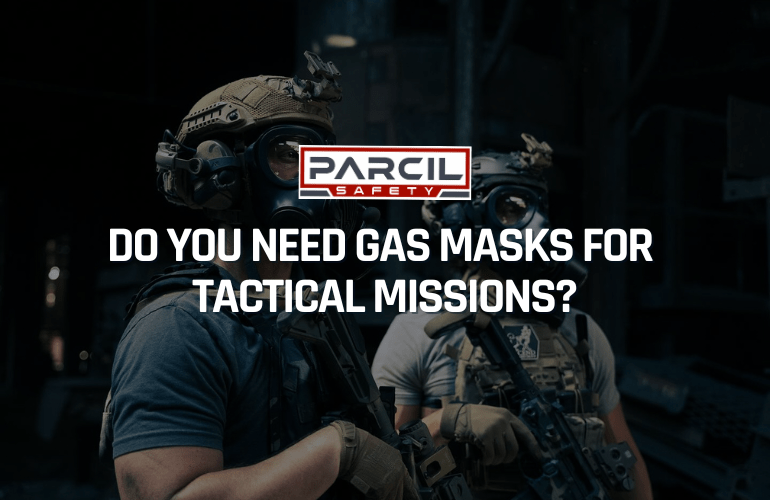Tactical teams operate in unpredictable environments. Smoke, chemical agents, industrial leaks, and riot control agents can appear suddenly and overwhelm unprotected personnel. A properly selected gas mask stops airborne hazards at the face, protects the eyes, and gives operators the time they need to perform mission-critical tasks and withdraw safely.
Government guidance says respirators must be selected to match the hazard and used as part of an established respiratory protection program. Employers and units are responsible for selecting the right respirator and training people to use it.
Common tactical threats that call for a gas mask

- Chemical irritants and riot control agents. These reduce effectiveness and can incapacitate unprotected personnel.
- Smoke and particulate hazards. Fire and explosions generate fine particles that impair breathing and vision.
- Toxic industrial chemicals. Accidents near industrial sites can release lethal vapors.
- Biological aerosols. In specific scenarios, airborne biological agents can present a risk.
Military and alliance doctrine expects units to plan for chemical, biological, radiological, and nuclear risks and to equip personnel with protective masks and training. This planning is part of modern CBRN posture in NATO and US military guidance.
Who on a team needs a gas mask?

Not everyone on an operation needs the same level of respiratory protection. Commanders and safety officers should decide based on mission type, threat intelligence, and expected exposure. Typical roles that should carry masks include: entry teams, medics, explosive ordnance personnel, and leaders who must stay operational to coordinate withdrawal and casualty care. Use risk assessments to assign gear and plan for rapid distribution.
How to choose the right mask and filters
Pick gear that matches the threat and mission profile. Key factors are seal performance, field of view, compatibility with communication systems, filter types, and ease of use under stress. Follow these practical rules:
- Choose a certified or military-grade design for known CBRN or industrial hazards.
- Match filters to the threat: particulate cartridges for dust and smoke, combined gas and particulate cartridges for chemical vapors.
- Ensure the mask supports your comms and weapon handling needs.
- Test fit and check face seal on every wearer before deployment.
- Use only approved filters and replace them per the manufacturer’s guidance.
Regulatory guidance requires selection and fitting to be part of a respiratory protection program. Training, fit testing, and care are not optional steps.
Explore Tactical Gas Masks Here
Training and tactics: how to operate in a mask
Training must cover donning and doffing, seal checks, emergency removal, and weapon handling while masked. Practiced crews complete basic donning and seal checks in seconds. Movement drills and live-fire familiarity let operators maintain marksmanship and communication while sealed. For detailed techniques on shooting while wearing a mask, see Parcil Safety’s guide on how to wear a gas mask and still fire a weapon effectively.
Limitations you must plan for
A gas mask protects the respiratory tract and eyes but does not replace mission planning or decontamination. Masks do not protect against heat injury, penetrating trauma, or long-term exposure without filter changes. Masks can interfere with communication and peripheral vision if they are not the right model for the task. Good planning accounts for rotation, filter resupply, and contingencies for degraded comms.
For questions about nuclear fallout and particulate hazards, read Parcil Safety’s explainer on masks and fallout.
Recommended tactical masks from Parcil Safety

If your mission profile requires robust, mission-ready protection, these Parcil Safety models are built to meet field demands:
-
CS-100 Riot Control Gas Mask with N-B-1 Defense Canister
https://parcilsafety.com/products/cs-100-riot-control-gas-mask-with-n-b-1-defense-canister -
ST-100X Gas Mask Respirator
https://parcilsafety.com/products/st100x-gas-mask-respirator -
NB-100 Tactical Gas Mask Full Face Respirator with 40mm Defense Filter
https://parcilsafety.com/products/nb-100-tactical-gas-mask-full-face-respirator-with-40mm-defense-filter -
IIR-100 Recon Gas Mask Full Face Butyl Rubber Respirator with N-B-1 40mm DefensePRO Filter
https://parcilsafety.com/products/iir-100-recon-gas-mask-full-face-butyl-rubber-respirator-with-n-b-1-40mm-defensepro-filter-canister
Each of these models supports field filtering options, durable face seals, and compatibility with standard 40mm filter types. Match the model to your communication needs, optical requirements, and expected exposure times.
Check Out All Our Military CBRN Gas Masks Here
Logistics, maintenance, and shelf life
Set a maintenance cycle for masks and filters. Inspect seals and straps before every mission. Store spare filters in airtight packaging and rotate stock with first-in, first-out discipline. Replace filters after exposure or as the manufacturer specifies. Programmed maintenance and a simple inventory system prevent expired or degraded filters from reaching the field.
OSHA and NIOSH guidance reserve respirator selection and maintenance as core components of a protection program. Treat logistics with the same priority you give ammunition and comms.
Legal and policy notes
Using respiratory protection in the field can intersect with workplace regulations and military directives. For formal employment settings, OSHA rules require employers to provide appropriate respirators and implement a respiratory protection program when exposure is anticipated. For military units, consult applicable service doctrine and CBRN guidance.
Practical checklist before every mission
- Confirm threat intelligence and pick filters accordingly.
- Verify fit for every team member with a seal check.
- Stage extra filters and a spare mask for each critical role.
- Run a masked dry fire or movement drill before deployment.
- Ensure comms compatibility and practice vocal clarity training.
- Log filter serials and service dates in your kit manifest.
Gas masks are not a universal requirement for every mission. Use risk-based decisions driven by intelligence and planned exposure. When the threat includes chemical agents, heavy smoke, or toxic industrial hazards, masks are mission-essential equipment. Invest in certified gear, regular training, and a logistics plan that keeps filters fresh and systems ready.
Parcil Safety develops tactical masks intended for field operations. For hands-on guidance about using masks effectively in dynamic environments, see our technical guides and product pages linked above.
Prepared, Not Scared.
Every Breath Matters.




















Leave a comment
All comments are moderated before being published.
This site is protected by hCaptcha and the hCaptcha Privacy Policy and Terms of Service apply.